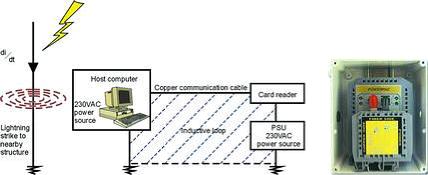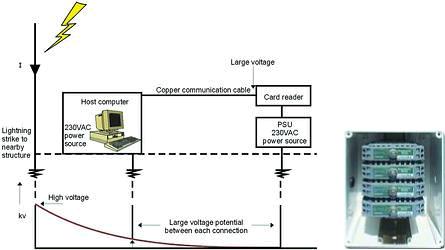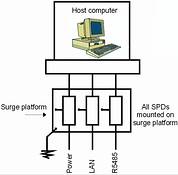
RS485 has been widely used in access control systems but is not immune to the effects of lightning and ground potential differences. A local company has developed some interesting ways to solve this problem.
Contrary to popular belief, direct lightning strikes account for only a small percentage of damage to electronic equipment. Over 99% of lightning damage stems from the induced effects and differences in ground potential during a lightning strike. When lightning strikes a tree, powerline or other structure, an enormous amount of energy is passed into the ground which sets up an intense electromagnetic field that will couple into communication and power cables. Access control systems suffer from this phenomenon in two ways:
Inductive coupling
In a simple access control system, a card reader will talk to a host computer some distance away via a copper communication cable. Both the host computer and card reader will be supplied with power from a 230 V a.c. source. An inductive loop is formed by the communication cable on the one end and power source on the other. This inductive loop will absorb energy from the lightning strike, even if the lightning strike is some distance away. The closer the lightning strike to the installation, the higher the voltage that will be developed within the loop. Damage to the equipment will result even if the equipment is switched off!

Ground potential differences
When lightning energy is passed into the ground, a very high potential exists at the point of contact. As one moves away from this point, the voltage along the current paths decreases very rapidly. If equipment is installed along these current paths and connected to the available safety earth system, large potential differences will exist between these earth connections. The result will be that equalisation will try and take place through the communication cables. One solution may be to try and interconnect the safety earths at both sites but this is usually impractical.

Practical solutions
Short circuit protection
This has been the traditional way of providing protection for communication systems. The protection element consists of an arrangement of gas arresters, metal oxide varistors and transorbs to divert the induced energy away from the equipment to be protected. Problems are normally encountered by the lack of an equipotential arrangement for protection of all the inputs and outputs of the equipment and so damage is still experienced. The correct arrangement for good protection is as per Figure 3.

In the example shown, a data and power protector have been fitted to the same housing and a good protection arrangement has been achieved. It is essential that all connections to the equipment to be protected be passed through the protection devices on the platform.
Fibre-optic systems
Fibre systems have been with us for a long time but have not been installed due to the high cost. There are now a number of low cost solutions that specifically cater for the access control market. As fibre is non-conductive, the problems of inductive loops and ground potential differences simply do not come into the picture. Using the fibre approach, only protection on the power supply needs to be implemented.
Glass fibre modules
There are many fibre-optic modules available and the example shown here may be din-rail mounted with its own power supply or fed from a 24 V d.c. source. Distances of up to 4 kilometres at speeds of 115 bps are easily obtained. These units are used with 62,5/125 µm or 20/125 µm multimode fibre.
Plastic fibre modules
A new development for ease of installation is fibre converters using 1 mm plastic fibre. The advantage of this type of system is that the installation technician can easily install these converters without expensive special tools or splicing equipment. The cable is installed, cut to length, and ends polished with an inexpensive kit as shown below. Twin plastic fibre cable comes on 500 m rolls and due to its small size, can easily be carried in the boot of a car. The usable length between converters is limited to about 120 m at 115 bps but still a viable option for small installations.

© Technews Publishing (Pty) Ltd. | All Rights Reserved.